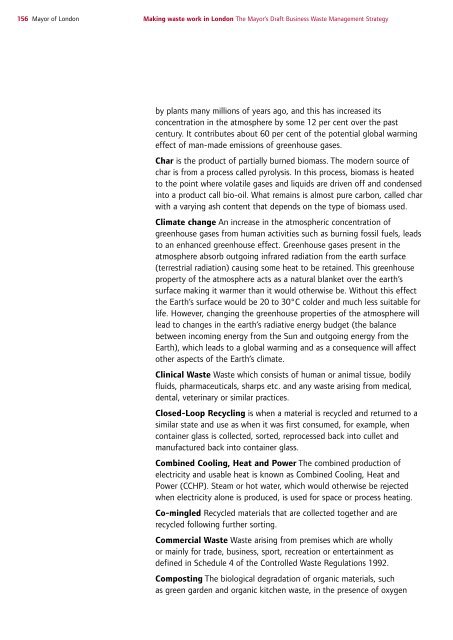Draft Business Waste Strategy PDF - london.gov.uk - Greater ...
Draft Business Waste Strategy PDF - london.gov.uk - Greater ...
Draft Business Waste Strategy PDF - london.gov.uk - Greater ...
You also want an ePaper? Increase the reach of your titles
YUMPU automatically turns print PDFs into web optimized ePapers that Google loves.
156 Mayor of London<br />
Making waste work in London The Mayor’s <strong>Draft</strong> <strong>Business</strong> <strong>Waste</strong> Management <strong>Strategy</strong><br />
by plants many millions of years ago, and this has increased its<br />
concentration in the atmosphere by some 12 per cent over the past<br />
century. It contributes about 60 per cent of the potential global warming<br />
effect of man-made emissions of greenhouse gases.<br />
Char is the product of partially burned biomass. The modern source of<br />
char is from a process called pyrolysis. In this process, biomass is heated<br />
to the point where volatile gases and liquids are driven off and condensed<br />
into a product call bio-oil. What remains is almost pure carbon, called char<br />
with a varying ash content that depends on the type of biomass used.<br />
Climate change An increase in the atmospheric concentration of<br />
greenhouse gases from human activities such as burning fossil fuels, leads<br />
to an enhanced greenhouse effect. Greenhouse gases present in the<br />
atmosphere absorb outgoing infrared radiation from the earth surface<br />
(terrestrial radiation) causing some heat to be retained. This greenhouse<br />
property of the atmosphere acts as a natural blanket over the earth’s<br />
surface making it warmer than it would otherwise be. Without this effect<br />
the Earth’s surface would be 20 to 30°C colder and much less suitable for<br />
life. However, changing the greenhouse properties of the atmosphere will<br />
lead to changes in the earth’s radiative energy budget (the balance<br />
between incoming energy from the Sun and outgoing energy from the<br />
Earth), which leads to a global warming and as a consequence will affect<br />
other aspects of the Earth’s climate.<br />
Clinical <strong>Waste</strong> <strong>Waste</strong> which consists of human or animal tissue, bodily<br />
fluids, pharmaceuticals, sharps etc. and any waste arising from medical,<br />
dental, veterinary or similar practices.<br />
Closed-Loop Recycling is when a material is recycled and returned to a<br />
similar state and use as when it was first consumed, for example, when<br />
container glass is collected, sorted, reprocessed back into cullet and<br />
manufactured back into container glass.<br />
Combined Cooling, Heat and Power The combined production of<br />
electricity and usable heat is known as Combined Cooling, Heat and<br />
Power (CCHP). Steam or hot water, which would otherwise be rejected<br />
when electricity alone is produced, is used for space or process heating.<br />
Co-mingled Recycled materials that are collected together and are<br />
recycled following further sorting.<br />
Commercial <strong>Waste</strong> <strong>Waste</strong> arising from premises which are wholly<br />
or mainly for trade, business, sport, recreation or entertainment as<br />
defined in Schedule 4 of the Controlled <strong>Waste</strong> Regulations 1992.<br />
Composting The biological degradation of organic materials, such<br />
as green garden and organic kitchen waste, in the presence of oxygen
















